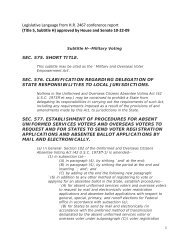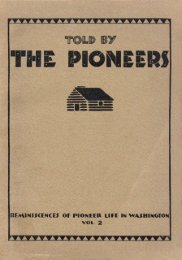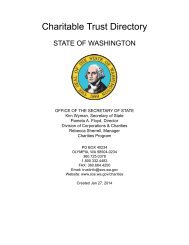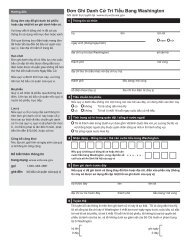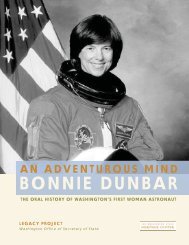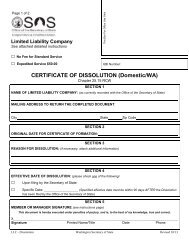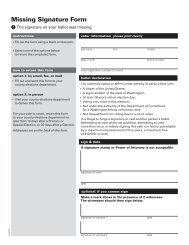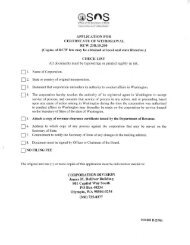- Page 1 and 2: Courtesy Northwest Indian Fisheries
- Page 4 and 5: Where the Salmon Run The Life and L
- Page 6: For Sugar, Tanu, and Willie “I’
- Page 9 and 10: viii contents 14. The Negotiator 20
- Page 12: Where the Salmon Run The Life and L
- Page 15 and 16: 4 prologue Early logging robbed the
- Page 17 and 18: 6 introduction promise as long as t
- Page 19 and 20: 8 introduction friend said, ‘But
- Page 21 and 22: Willie Frank Sr. Mary Randlett
- Page 23 and 24: 12 spirit of the father chair—fla
- Page 25 and 26: 14 spirit of the father Outstretche
- Page 27: 16 spirit of the father including t
- Page 31 and 32: 20 spirit of the father Nisqually T
- Page 33 and 34: 22 spirit of the father The free ed
- Page 35 and 36: 24 spirit of the father my pants. S
- Page 37 and 38: 26 spirit of the father Hank Adams
- Page 39 and 40: 28 spirit of the father of the Nisq
- Page 41 and 42: 30 spirit of the father good now,
- Page 43 and 44: 32 “i live here!” Billy Frank J
- Page 45 and 46: 34 “i live here!” Hank Adams pe
- Page 47 and 48: 36 “i live here!” Billy Frank J
- Page 49 and 50: 38 “i live here!” endured a str
- Page 51 and 52: 40 “i live here!” Willie catapu
- Page 53 and 54: 42 “i live here!” boarding-scho
- Page 55 and 56: 44 “i live here!” kerosene lamp
- Page 57 and 58: Chapter 3 The Survivor Dubbed the f
- Page 59 and 60: 48 the survivor Georgiana Kautz per
- Page 61 and 62: 50 the survivor joined the Internat
- Page 63 and 64: 52 the survivor home from the hospi
- Page 65 and 66: 54 the survivor the pain.” Billy
- Page 67 and 68: 56 the survivor She put her other b
- Page 69 and 70: Chapter 4 Surveillance Years after
- Page 71 and 72: 60 surveillance to get our salmon b
- Page 73 and 74: 62 surveillance attempted to form t
- Page 75 and 76: 64 surveillance Washington State Ar
- Page 77 and 78: 66 surveillance the only women or c
- Page 79 and 80:
68 renegades Hank Adams personal co
- Page 81 and 82:
70 renegades the kitchen table and
- Page 83 and 84:
72 renegades dates, court cases, an
- Page 85 and 86:
74 renegades for treaty rights shak
- Page 87 and 88:
76 renegades When we got stronger,
- Page 89 and 90:
78 renegades I just looked at him a
- Page 91 and 92:
80 renegades you know, bank robbers
- Page 93 and 94:
Chapter 6 Canoes and Clashes It is
- Page 95 and 96:
84 canoes and clashes Willie Frank
- Page 97 and 98:
86 canoes and clashes Northwest Ind
- Page 99 and 100:
88 canoes and clashes and chaos eru
- Page 101 and 102:
90 canoes and clashes Wolf accused
- Page 103 and 104:
92 canoes and clashes blackjack con
- Page 105 and 106:
94 as long as the rivers run Washin
- Page 107 and 108:
96 as long as the rivers run at tha
- Page 109 and 110:
98 as long as the rivers run Hank A
- Page 111 and 112:
100 as long as the rivers run as a
- Page 113 and 114:
102 as long as the rivers run restr
- Page 115 and 116:
104 as long as the rivers run presi
- Page 117 and 118:
106 as long as the rivers run Carol
- Page 119 and 120:
108 as long as the rivers run on hi
- Page 121 and 122:
Chapter 8 Takeovers Like the regal
- Page 123 and 124:
112 takeovers Seattle Municipal Arc
- Page 125 and 126:
114 takeovers a journalist in bewil
- Page 127 and 128:
116 takeovers time at the camp. Bil
- Page 129 and 130:
118 takeovers A bridge was charred
- Page 131 and 132:
120 takeovers Calling the bia the N
- Page 133 and 134:
122 takeovers retired judge from Wa
- Page 135 and 136:
124 takeovers fishermen family and
- Page 137 and 138:
126 takeovers Lut Indian School fou
- Page 139 and 140:
Chapter 9 The Shelf Life of Treatie
- Page 141 and 142:
130 the shelf life of treaties Wash
- Page 143 and 144:
132 the shelf life of treaties Depa
- Page 145 and 146:
134 the shelf life of treaties “G
- Page 147 and 148:
136 the shelf life of treaties self
- Page 149 and 150:
138 the shelf life of treaties Nisq
- Page 151 and 152:
140 the shelf life of treaties esta
- Page 153 and 154:
Chapter 10 Storm The backlash to th
- Page 155 and 156:
144 storm because of the enormous a
- Page 157 and 158:
146 storm fishing away from reserva
- Page 159 and 160:
148 storm Decision created within g
- Page 161 and 162:
150 storm In the summer of 1976, Ji
- Page 163 and 164:
152 storm The engine of the Alaskan
- Page 165 and 166:
154 storm In 1976, as the nation ce
- Page 167 and 168:
156 storm The year 1977 was punctua
- Page 169 and 170:
158 storm Georgiana Kautz personal
- Page 171 and 172:
160 storm softball in tournaments i
- Page 173 and 174:
162 storm If a silver lining follow
- Page 175 and 176:
164 the politics of salmon Washingt
- Page 177 and 178:
166 the politics of salmon stood at
- Page 179 and 180:
168 the politics of salmon Accordin
- Page 181 and 182:
170 the politics of salmon 1976, il
- Page 183 and 184:
172 the politics of salmon keeping
- Page 185 and 186:
174 the politics of salmon Post dec
- Page 187 and 188:
176 bridge builder Dick Baldwin, Wa
- Page 189 and 190:
178 bridge builder attended a myria
- Page 191 and 192:
180 bridge builder to see Indians i
- Page 193 and 194:
182 bridge builder appeal process t
- Page 195 and 196:
184 bridge builder Things started t
- Page 197 and 198:
186 bridge builder Although most pe
- Page 199 and 200:
188 bridge builder groups acknowled
- Page 201 and 202:
Chapter 13 Resilience Billy is some
- Page 203 and 204:
192 resilience Billy Frank Jr. pers
- Page 205 and 206:
194 resilience On June 17, 1983, Wi
- Page 207 and 208:
196 resilience to rest here. He nev
- Page 209 and 210:
198 resilience says. “One friend,
- Page 211 and 212:
Chapter 14 The Negotiator The 1980s
- Page 213 and 214:
202 the negotiator migrated up the
- Page 215 and 216:
204 the negotiator pretty fast once
- Page 217 and 218:
206 the negotiator Fish and Wildlif
- Page 219 and 220:
208 the negotiator In August 1989,
- Page 221 and 222:
210 clear creek hatchery Joe Kenned
- Page 223 and 224:
212 clear creek hatchery Puget Soun
- Page 225 and 226:
214 clear creek hatchery hatchery i
- Page 227 and 228:
216 clear creek hatchery In Salmon
- Page 229 and 230:
218 submerged Hank Adams personal c
- Page 231 and 232:
220 submerged Hank Adams personal c
- Page 233 and 234:
222 submerged Keefe says. “Now, t
- Page 235 and 236:
Chapter 17 The Tough Guy Along with
- Page 237 and 238:
226 the tough guy the former govern
- Page 239 and 240:
228 the tough guy convinced that ou
- Page 241 and 242:
230 the tough guy Second, and perha
- Page 243 and 244:
Chapter 18 “You were always there
- Page 245 and 246:
234 “you were always there for me
- Page 247 and 248:
236 “you were always there for me
- Page 249 and 250:
238 the catalyst Hank Adams persona
- Page 251 and 252:
240 the catalyst Hank Adams persona
- Page 253 and 254:
242 the catalyst conferences, he ur
- Page 255 and 256:
244 the catalyst Billy Frank Jr. wo
- Page 257 and 258:
246 the catalyst Billy sat at the U
- Page 259 and 260:
Chapter 20 Operation Chainsmoker Fr
- Page 261 and 262:
250 operation chainsmoker Indian la
- Page 263 and 264:
252 operation chainsmoker Frank’s
- Page 265 and 266:
254 operation chainsmoker “Unders
- Page 267 and 268:
256 hard truths The invisible kille
- Page 269 and 270:
258 hard truths kills typically sym
- Page 271 and 272:
260 hard truths their negotiations
- Page 273 and 274:
262 hard truths The only people tha
- Page 275 and 276:
264 hard truths number of pups has
- Page 277 and 278:
266 hard truths behind dam walls. S
- Page 279 and 280:
268 dreams and legacies Hank Adams
- Page 281 and 282:
270 dreams and legacies Hank Adams
- Page 283 and 284:
272 dreams and legacies Northwest I
- Page 285 and 286:
274 dreams and legacies Frank. They
- Page 287 and 288:
276 dreams and legacies his childre
- Page 289 and 290:
278 dreams and legacies law, have b
- Page 291 and 292:
280 dreams and legacies John Elliot
- Page 293 and 294:
282 dreams and legacies Billy Frank
- Page 295 and 296:
284 acknowledgments with all else,
- Page 297 and 298:
286 billy frank jr. family tree Cry
- Page 299 and 300:
288 billy frank jr. family tree Joh
- Page 301 and 302:
290 billy frank jr. family tree Klu
- Page 303 and 304:
Source Notes Unless otherwise noted
- Page 305 and 306:
294 source notes background on Indi
- Page 307 and 308:
296 source notes May Be Next If Ind
- Page 309 and 310:
298 source notes Times, “Indian A
- Page 311 and 312:
300 source notes Wildlife internal
- Page 313 and 314:
302 source notes the harm,” “At
- Page 315 and 316:
304 source notes Record, 15 Mar 15,
- Page 317 and 318:
306 source notes 12th year on Endan
- Page 319 and 320:
308 select bibliography Cynthia Iya
- Page 321 and 322:
310 select bibliography Wilkinson,
- Page 323 and 324:
Index A Aberdeen Daily World 201 Ad
- Page 325 and 326:
314 index Crowe, John O. 121 Crysta
- Page 327 and 328:
316 index Indian Self-Determination
- Page 329 and 330:
318 index Nisqually Hill 87 Nisqual
- Page 331 and 332:
320 index Spokesman Review 182 Spor
- Page 333:
322 index Y Yakama Nation 94, 112,



